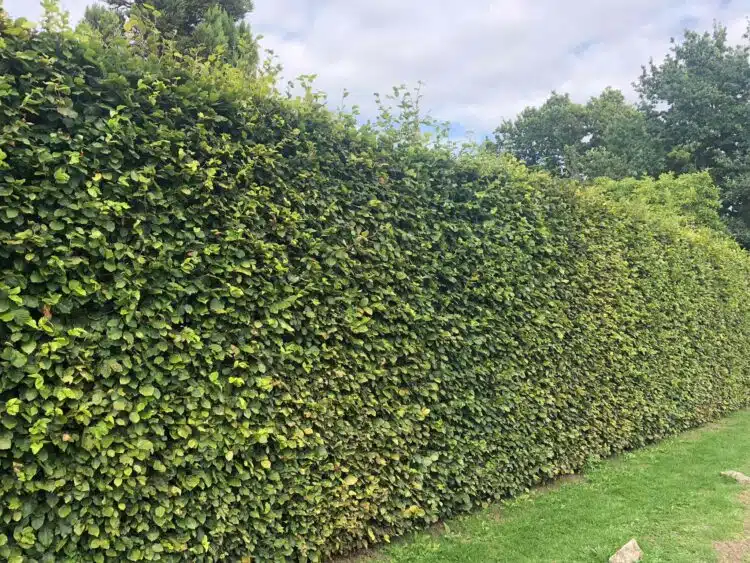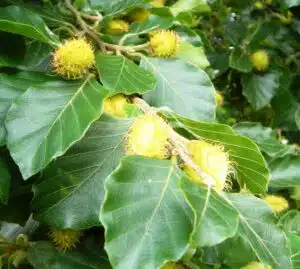HALF PRICE SALE ON EVERYTHING ENDS ON FRIDAY
NEW SEASON BARE ROOTS AT 50% OFF LAST SEASONS PRICES – ENDS 31 JULY
***TODAY ONLY – GET AN EXTRA 10% OFF SALE PRICES WITH CODE FLASH10***
Menu
HALF PRICE SALE ON EVERYTHING ENDS ON FRIDAY
NEW SEASON BARE ROOTS AT 50% OFF LAST SEASONS PRICES – ENDS 31 JULY
***TODAY ONLY – GET AN EXTRA 10% OFF SALE PRICES WITH CODE FLASH10***
 https://www.hopesgrovenurseries.co.uk/wp-content/uploads/2024/02/IMG_1414-750x563.jpg
BEECH HEDGE FAGUS SYLVATICA
https://www.hopesgrovenurseries.co.uk/wp-content/uploads/2024/02/IMG_1414-750x563.jpg
BEECH HEDGE FAGUS SYLVATICA
National Tree Week is upon us and it always happens in around the last week of November and the beginning of December. This is just the time when the beech trees above my cottage are deciding whether to let all their autumn-tinted leaves go to ground, or not. The wind usually makes the final decision for them. Then they flutter past my windows, spinning as they go, and join the rest.
Once they’re off, or mostly off, I’ll go serious leaf gathering with my silent rubber rake, not one of those vibrating, neighbour-blasting leaf blowers. The slow, rhythmical raking movement is the perfect antidote to the rush and bustle of most of the gardening year. It also keeps me warm and the leaves make good leaf litter for my woodland patch – eventually. Beech leaves contain more lignin, an organic polymer, than most other leaves and that’s why they feel almost brittle to the touch. They will take a full year to rot down.
The beech trees around my cottage began life as a hedge, planted some thirty-five years ago. They were left to go feral. If they had been given the customary once-a-year trim every August, they would still be in fine shape. For the beech is enduring whether it’s hedge, or tree. The tallest hedge in the world is actually a beech hedge at Meilleour in Perthshire, according to British Trees edited by Archie Miles. The men who planted the ten-mile-long hedge in 1745, were called away to fight at the Battle of Culloden. They hid their tools underneath, but never returned to reclaim them. It’s now a hundred feet high and said to be visible for the A39. In fact, you could probably see it from the Space Station! It’s trimmed every 10 years, but it takes four men six weeks to complete the job. Moral being: trim your hedge every year!

The great thing about regularly trimmed beech hedges is, they never look bare in winter. They always hold on to some of their leaves and this process is called marcescence. This delicious-sounding word conjures up a squidgy Italian pudding – to my mind – which tends to concentrate on food. And this tree DOES grow as far south as Sicily, the home of delicious food, and on and up to southern Sweden. It’s unknown whether the common beech is native to the UK, because reliable pollen records only go back 3000 years. The natural range is south of line drawn from The Wash and the Severn estuary, along with south-east Wales.
In this country Common Beech, Fagus sylvaticus, is found on well-drained open land, principally chalk, limestone and light loamy ground. It also colonises the slopes of the rivers Wye and Conwy because the rainfall drains down the valley. The trees seem to perch in mid-air, but their roots stabilise the banks and slopes. If you’re on wetter ground, they will sulk and you’d be better to grow hornbeam, a much better option for wetter soil. They’re both similar. If in doubt, do a local recce and look at the hedges growing nearby.
The chalky Chiltern Hills are a stronghold for the beech tree and its Anglo-Saxon name, boc, gave Buckinghamshire its county name. The word book is from the same root, because beech was used to cover sheets of vellum. Beech wood burns slowly, but it’s also used in chair making. The woods around High Wycombe were used by hundreds of bodgers and some still practise the art. They turned the legs on their outdoor lathes and the trees were regularly pollarded to encourage suitably sized branches. Pollarding, done in stages, is still being carried out at Burnham Beeches and the trees there are four hundred years old.
Winchester Cathedral is sited in marshy ground and the Norman stonework was laid down on top of beech trunks, sunk into the marsh. The beech wood was examined at the beginning of the 19th century, when it was 700-years old, and found to be sound. The wood is often used for sluice gates too.
The Great Storm of 1987 upended many of our veteran beeches in southern England. It demonstrated how shallow-rooted they are. However veteran trees, with some hollowing in their trunks and boughs, survived because the wind went through them. These gnarled trees support a lot of wildlife, including bats and owls. After the Great Storm, replanting of saplings took place in short order, but it wasn’t very successful. The trees were far better at regenerating themselves and, when another storm struck in 1990, natural regeneration was allowed to happen.
Gilbert White (1720-1793), the first ecologist and naturalist, wrote about Selborne’s Beech Hanger on the chalky hills of Hampshire. The hanger, a double line of trees, still exists today and Gilbert White may well have known the same trees, if a little shorter. The steep slope they grown on hasn’t encouraged foresters to alter or subdue them. Beech also grows in the acid soil of The New Forest and on Dartmoor, although the savage weather on Devon’s moor shapes their form and stunts them.
Beech hedges are very good for wildlife, particularly birds. My previous garden, in Hook Norton, had a hundred-yard-long, well-maintained twiggy hedge. Thrushes and blackbirds nested in spring, at chest height normally. The robin and wren were nearer the ground, but high summer saw the goldfinches take to the upper reaches. On one windy August day, two nests blew to the ground sadly.
That hedge was also a bit of a barometer. On cold spring days the leaves would rustle and I grew to fear the sound. It meant a cold wind from the north or east was blowing and that was the day to don an extra layer, but gardeners are used to that. Rustling beech leaves still make me shiver today, although I left Hook Norton almost twenty years ago.
The trees around my lowly cottage, or should that be above it, reflect each season. In winter sun, the trunks take on a silvery sheen, but this changes after rain to khaki, grey and black camouflage fatigues. Winter light illuminates the graceful beech canopy, above the trunk, and this majestic and statuesque tree is deservedly known as the Queen of Trees. The oak is King.
Spring sees the pointed buds of beech expand and form shiny torpedoes, poised to go. Then the lime-green, spring-zing foliage begins to break through, in the warmer spots first. That usually happens in the third week of April here and it’s a landmark moment. The pigeons think so too, for they gobble up the new leaves with gusto. Rounded catkins appear, for not all have lamb’s tails like the hazel. The bee-friendly catkins, which contain male and female flowers, are wind pollinated. The trees overhanging my garden produce copious amounts of beechmasts every year, probably because we’re so windy and exposed.

In the wild, not many plants manage to grow underneath its dense summer canopy. Bluebells are the exception and they unfurl their cobalt-blue flowers just as the new vivid-green foliage appears. It’s an iconic sight in early May. Helleborines and woodland orchids may join in later, but apart from that little grows under beech trees. That makes them more dramatic, almost cathedral-like for they dominate their own their space.
In the garden, the foliage goes a duller green and, by late summer, the prickly four-lobed seed cases are clearly visible. Then the beechmasts begin to drop, pinging against the shed roof and on the cars. Pigeons and squirrels begin to feast. The seeds are appreciated by voles and mice and, should they manage to infiltrate my cottage, I will find neat piles of them! Squirrels often add them to my pots of bulbs, along with hazel nuts and walnuts.
The beechmast and acorns in The New Forest are cleared by pigs owned by the commoners. Pannage allows them to forage on the common land. The pigs were released on the 11th September this year and they’re allowed to graze for 60 days. Nose rings are fitted, to lessen the damage cause by piggy snouts. This ancient practice clears the forest floor of acorns and beechmast. Both are poisonous to the wild ponies.
The likelihood is, that you won’t have room, time, or the desire to grow a veteran beech. However, you can get a good beech hedge within a few years and it will endure for many a year. It will get bushier with a yearly trim, but don’t top your hedge and until it has nearly reached your desired height. Trim the sides only. Once established it will make a good feature, throughout the year, and it will shine in winter and rustle its leaves.
Four types of beech plants are available from Hopes Grove Nurseries. Bare-root, pot-grown, root-balled and Instant hedging. Use between 3 and 7 per square metre for shorter whips and between 3 and 5 for 3-year-old, four-feet high whips. If you buy root ball or potted hedging the planting density falls to 1 or 2 per metre. Instant hedging, grown in troughs, is also available.
Many of our customers buy topiary plants (and hedging plants) to grow in containers, one frequently asked question is how large does the pot that I plant them into need to be?
Expert horticultural advice on the merits and pitfalls of planting bare root yews, and how to get the best from them.
Pleached trees are a garden-design favourite, because they provide an instant leafy screen that looks stylish as soon as it’s planted. They offer privacy for you and they help to muffle noise and that’s becoming more important in our busy world. They provide a living screen that’s far more eco-friendly than a stark wooden fence…